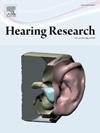Toward cognitive models of misophonia
IF 2.5
2区 医学
Q1 AUDIOLOGY & SPEECH-LANGUAGE PATHOLOGY
引用次数: 0
Abstract
Misophonia is a disorder in which specific common sounds such as another person breathing or chewing, or the ticking of a clock, cause an atypical negative emotional response. Affected individuals may experience anger, irritability, annoyance, disgust, and anxiety, as well as physiological autonomic responses, and may find everyday environments and contexts to be unbearable in which their ‘misophonic stimuli’ (often called ‘trigger sounds’) are present. Misophonia is gradually being recognized as a genuine problem that causes significant distress and has negative consequences for individuals and their families. It has only recently come under scientific scrutiny, as researchers and clinicians are establishing its prevalence, distinguishing it from other disorders of sensory sensitivity such as hyperacusis, establishing its neurobiological bases, and evaluating the effectiveness of potential treatments. While ideas abound as to the mechanisms involved in misophonia, few have coalesced into models. The aim of the present work is to summarize and extend recent thinking on the mechanistic basis of misophonia, with a focus on moving towards neurologically-informed cognitive models that can (a) account for extant findings, and (b) generate testable predictions. We hope this work will facilitate future refinements in our understanding of misophonia, and ultimately inform treatments.
恐音症的认知模型。
恐音症是一种特定的常见声音,如他人的呼吸、咀嚼或时钟的滴答声,会引起非典型的负面情绪反应的疾病。受影响的个体可能会感到愤怒、烦躁、烦恼、厌恶和焦虑,以及生理上的自主反应,并且可能会发现他们的“恐音刺激”(通常称为“触发音”)存在的日常环境和背景是无法忍受的。恐音症正逐渐被认为是一个真正的问题,它会给个人及其家庭带来巨大的痛苦和负面影响。直到最近,随着研究人员和临床医生确定其患病率,将其与其他感觉敏感性疾病(如听觉亢进)区分开来,建立其神经生物学基础,并评估潜在治疗的有效性,它才受到科学的审视。虽然关于恐音症的机制有很多想法,但很少有能整合成模型的。目前工作的目的是总结和扩展最近对恐音症的机制基础的思考,重点是向神经学上的认知模型移动,这些模型可以(a)解释现有的发现,(b)产生可测试的预测。我们希望这项工作将促进未来我们对恐音症的理解,并最终为治疗提供信息。
本文章由计算机程序翻译,如有差异,请以英文原文为准。
求助全文
约1分钟内获得全文
求助全文
来源期刊

Hearing Research
医学-耳鼻喉科学
CiteScore
5.30
自引率
14.30%
发文量
163
审稿时长
75 days
期刊介绍:
The aim of the journal is to provide a forum for papers concerned with basic peripheral and central auditory mechanisms. Emphasis is on experimental and clinical studies, but theoretical and methodological papers will also be considered. The journal publishes original research papers, review and mini- review articles, rapid communications, method/protocol and perspective articles.
Papers submitted should deal with auditory anatomy, physiology, psychophysics, imaging, modeling and behavioural studies in animals and humans, as well as hearing aids and cochlear implants. Papers dealing with the vestibular system are also considered for publication. Papers on comparative aspects of hearing and on effects of drugs and environmental contaminants on hearing function will also be considered. Clinical papers will be accepted when they contribute to the understanding of normal and pathological hearing functions.
 求助内容:
求助内容: 应助结果提醒方式:
应助结果提醒方式:


